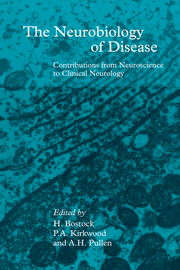Book contents
- Frontmatter
- Contents
- List of contributors
- Preface
- Part I Physiology and pathophysiology of nerve fibres
- 1 Ion channels in normal and pathophysiological mammalian peripheral myelinated nerve
- 2 Molecular anatomy of the node of Ranvier: newer concepts
- 3 Delayed rectifier type potassium currents in rabbit and rat axons and rabbit Schwann cells
- 4 Axonal signals for potassium channel expression in Schwann cells
- 5 Ion channels in human axons
- 6 An in vitro model of diabetic neuropathy: electrophysiological studies
- 7 Autoimmunity at the neuromuscular junction
- 8 Immunopathology and pathophysiology of experimental autoimmune encephalomyelitis
- 9 Pathophysiology of human demyelinating neuropathies
- 10 Conduction properties of central demyelinated axons: the generation of symptoms in demyelinating disease
- 11 Mechanisms of relapse and remission in multiple sclerosis
- 12 Glial transplantation in the treatment of myelin loss or deficiency
- Part II Pain
- Part III Control of central nervous system output
- Part IV Development, survival, regeneration and death
- Index
9 - Pathophysiology of human demyelinating neuropathies
from Part I - Physiology and pathophysiology of nerve fibres
Published online by Cambridge University Press: 04 August 2010
- Frontmatter
- Contents
- List of contributors
- Preface
- Part I Physiology and pathophysiology of nerve fibres
- 1 Ion channels in normal and pathophysiological mammalian peripheral myelinated nerve
- 2 Molecular anatomy of the node of Ranvier: newer concepts
- 3 Delayed rectifier type potassium currents in rabbit and rat axons and rabbit Schwann cells
- 4 Axonal signals for potassium channel expression in Schwann cells
- 5 Ion channels in human axons
- 6 An in vitro model of diabetic neuropathy: electrophysiological studies
- 7 Autoimmunity at the neuromuscular junction
- 8 Immunopathology and pathophysiology of experimental autoimmune encephalomyelitis
- 9 Pathophysiology of human demyelinating neuropathies
- 10 Conduction properties of central demyelinated axons: the generation of symptoms in demyelinating disease
- 11 Mechanisms of relapse and remission in multiple sclerosis
- 12 Glial transplantation in the treatment of myelin loss or deficiency
- Part II Pain
- Part III Control of central nervous system output
- Part IV Development, survival, regeneration and death
- Index
Summary
Introduction
This chapter will review our understanding of the pathophysiology of the human demyelinating neuropathies with particular emphasis on acute Guillain–Barré syndrome (GBS). Abnormalities of conduction in peripheral nerves are secondary to changes in the axon or its myelin sheath. Those affecting the axon include neuronal or axonal degeneration, axonal shrinkage and, theoretically, alterations of ion channels. The last are usually pharmacological or toxicological. Abnormalities of myelin include demyelination, both segmental and paranodal, and reduced thickness of the sheath. The two major pathological lesions, axonal degeneration and demyelination, are sufficient to explain most of the clinical and physiological deficits in GBS.
Demyelination and conduction block
The first inference of conduction block was by Erb (1876) who studied focal traumatic nerve lesions. He observed that, in some patients, faradic stimulation could activate the nerve distal to a lesion. He postulated that the nerve fibres had not degenerated. Just a few years later, Gombault (1881) demonstrated myelin sheath abnormalities at the site of focal nerve lesions but these observations were not linked to those of Erb.
Seddon (1943), in his studies of war nerve injuries, classified them into three categories: neurotmesis, axonotmesis and neurapraxia. The first two were characterized by transection of the whole nerve and the axons respectively, with degeneration of the distal portions of the axons. In neurapraxia, however, the nerve trunk remained intact, the distal axons did not degenerate and recovery occurred after a short interval.
- Type
- Chapter
- Information
- The Neurobiology of DiseaseContributions from Neuroscience to Clinical Neurology, pp. 86 - 94Publisher: Cambridge University PressPrint publication year: 1996

